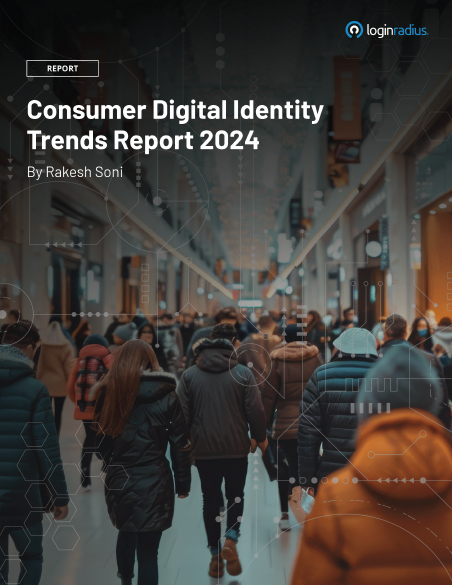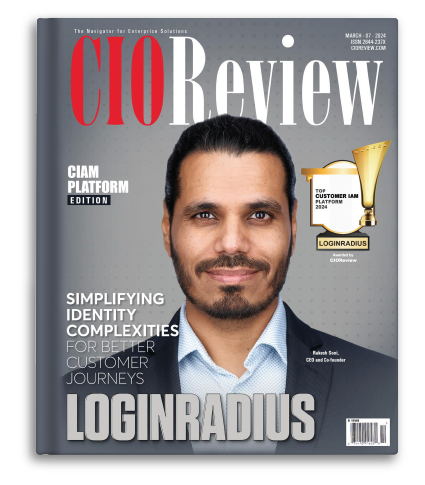Gone are the days when you could simply rely upon your user credentials – username and password – to secure your account. With the increasing number and complexity of cyberattacks, companies need to innovate and develop newer forms of securing their user devices and accounts. As an example, mobile phone users are now accustomed to using alternative modes of authentication like gestures and screen lock patterns – that are gradually replacing passwords.
As the number of smartphone users keeps increasing, biometric solutions are gaining more popularity as they add to the overall user experience and are less intrusive than entering passwords.
What is mobile biometric authentication – and what are its common use cases? Let us discuss that in the following sections.
What Is Mobile Biometric Authentication
In simple terms, mobile biometric authentication is a form of authentication that uses biometrics to detect and authenticate the identity of the user trying to access a mobile app. It can be performed using multiple ways including fingerprint readers, facial recognition, voice recognition, and more.
These biometric tools can either be an addition – or a replacement – for the traditional username-password method.
How is biometrics in mobile devices enabled? Most of the latest smartphones – using Apple, Android, and Microsoft technologies – are now fitted with advanced digital sensors such as touch screens, cameras, fingerprint scanners, and microphones that are facilitating user authentication.
Why is mobile biometric authentication gaining widespread popularity? Here are some reasons:
- Biometrics allows devices to use your physical attributes – fingerprints, face, voice, or even iris color – to authenticate your identity. This adds to your overall online experience, in place of passwords that are hard to remember.
- Biometrics can also be used as part of the multi-factor authentication (MFA) process – especially when signing into sensitive or confidential accounts.
Next, let us look at a few use cases of biometric authentication in mobile phones.
Biometric Authentication for Mobile Devices
Native vs. In-App Biometrics
-
Native Biometrics:
- Utilizes built-in hardware sensors on the device such as fingerprint readers, facial recognition cameras, and voice recognition microphones.
- Offers seamless integration with the device's operating system for quick and secure authentication.
-
In-App Biometrics:
- Requires developers to implement biometric authentication within the app using software development kits (SDKs).
- Provides more flexibility in customization and additional security layers specific to the app's requirements.
Multimodal Biometric Authentication
-
Combining Biometric Modalities:
- Enhances security by using multiple biometric identifiers such as fingerprint and facial recognition together.
- Provides increased accuracy and reduces the risk of false positives or negatives.
Benefits of Biometric Authentication for Mobile Devices
1. Enhanced Security
* Replaces traditional passwords with unique biometric identifiers, reducing the risk of unauthorized access.
* Protects sensitive data and transactions with a personalized authentication method.2. Improved User Experience
* Offers a convenient and user-friendly way to access mobile apps without the need to remember complex passwords.
* Speeds up the authentication process, saving users time and effort.3. Reduced Fraud and Identity Theft
* Mitigates the risk of fraudulent activities as biometric features are difficult to replicate or forge.
* Prevents unauthorized access even if a device is lost or stolen.Best Practices for Biometric Authentication on Mobile Devices
-
Secure Storage of Biometric Data:
- Ensure biometric data is securely stored on the device's secure enclave or trusted execution environment.
- Avoid transmitting biometric data over insecure networks to prevent interception.
-
Regular Updates and Patches
- Keep the biometric authentication system updated with the latest security patches and firmware updates.
- Address any vulnerabilities promptly to maintain the integrity of the authentication process.
-
User Consent and Privacy Protection
- Obtain explicit consent from users before collecting and using their biometric data.
- Implement transparent privacy policies regarding the storage and usage of biometric information.
-
Testing and Validation
- Conduct thorough testing of the biometric authentication system to ensure accuracy and reliability.
- Validate the system's performance across diverse user demographics and environmental conditions.
-
Fallback Authentication Methods
- Provide alternative authentication methods (e.g., PIN or password) as backup options in case of biometric authentication failure.
- Enable users to reset or re-enroll biometric data if needed for troubleshooting purposes.
Mobile Biometric Authentication – Use Cases
Mobile biometric authentication is being used in a variety of applications across industries. Here are a few use cases:
- Mobile banking
Biometric security is among the major challenges for banks and fintech companies. They are using biometrics to authenticate transactions being performed using mobile banking. Additionally, banks are using biometric authentication to validate banking customers when they try to access their mobile banking app or bank accounts. For instance, HSBC Bank has introduced the fingerprint and touch method for its customers to sign into their mobile banking app.
Some financial institutions are also considering biometric authentication – as a replacement for PINs or passwords and even digital signatures.
- Online retail
Another popular use case – particularly for facial recognition – is in online or eCommerce retail. Online shoppers often abandon their shopping cart or their purchases when they forget their passwords or the normal sign-in procedure is too time-consuming. Facial biometrics can resolve this problem for online shoppers and increase retail business.
For instance, Mastercard has introduced its Identity Check Mobile – the mobile-based biometric authentication solution. Using this mobile app, online shoppers can verify their identity by capturing and sending their selfies to the online retailer's website.
- Healthcare
The use of biometrics also has widespread application in the field of healthcare. Biometric information – obtained through fingerprint and iris scanning, and facial recognition can enable hospitals to identify patients and retrieve their medical history. This ensures that healthcare facilities can provide the right treatment by having access to the correct information.
As an example, New York-based Northwell Health is using iris scanning and face recognition technology to identify patients in emergency situations – thus preventing any patient fraud or wrong prescriptions.
Comparative Analysis of Biometric Authentication Methods
In the realm of biometric authentication, various methods exist to verify users' identities, each with its unique strengths and limitations. Let's delve into a comparative analysis of these methods:
Fingerprint Recognition
Strengths:
- Widely adopted and accepted.
- High accuracy in most scenarios.
- Convenient for users, especially on mobile devices.
Weaknesses:
- Can be impacted by dirt, moisture, or physical damage to fingers.
- Concerns about privacy if fingerprint data is compromised.
Facial Recognition
Strengths:
- Contactless, making it hygienic.
- Natural and intuitive for users.
- Can work in various lighting conditions.
Weaknesses:
- Vulnerable to spoofing with photos or videos.
- Accuracy may decrease in poor lighting or when faces are partially obscured.
Voice Recognition
Strengths:
- Contactless and convenient.
- Difficult to replicate or spoof.
- Can be combined with other biometric methods for multi-factor authentication.
Weaknesses:
- Vulnerable to background noise or changes in voice due to illness.
- Users may find it less natural or comfortable.
Iris Recognition
Strengths:
- Highly accurate and difficult to spoof.
- Contactless and hygienic.
- Less impacted by external factors like lighting or facial changes.
Weaknesses:
- Requires specialized hardware.
- Can be slower and less convenient for everyday use.
Challenges and Solutions in Mobile Biometric Authentication
While mobile biometric authentication offers significant advantages, it also presents unique challenges that need to be addressed for optimal implementation. Let's explore these challenges and the solutions:
Challenges:
- Security Concerns: Biometric data breaches could have severe consequences.
- Accuracy and Reliability: Ensuring biometric systems work accurately in various conditions.
- User Acceptance: Some users may be hesitant to adopt biometric methods due to privacy concerns.
Solutions:
- Encryption and Protection: Employ robust encryption methods to safeguard biometric data both in transit and at rest.
- Continuous Improvement: Invest in research and development to enhance the accuracy and reliability of biometric systems.
- Transparency and Education: Educate users about how their biometric data is used and stored, building trust and acceptance.
Introducing LoginRadius Biometric Authentication for Mobile Apps
For both Android and iOS mobile phones, LoginRadius is offering biometric authentication in the form of Face ID and Touch ID. How does this work? Let us take each case:
- Touch ID is the form of biometric authentication where smartphone users are authenticated with their fingerprints.
- Face ID allows customer authentication using their facial features.
LoginRadius offers both these options whenever the consumer tries to open their app. Depending on their individual preference, they can choose to set up the form of ID that they are comfortable with.
How does LoginRadius Biometric Authentication benefit smartphone users and business enterprises?
- Easy to configure on any Android or Apple iOS device.
- Easy for consumer use as they no longer need to remember passwords to access different apps.
- Face and Touch-related data for each consumer are locally stored on their phones – and not on any central server or repository where they could be hacked or compromised through any data breach.
- Beneficial for consumers who are already familiar with the biometric way of authentication.
- Beneficial for app developers and companies as they do not need to capture or store the consumer’s biometric information.
Conclusion
In the evolving landscape of cybersecurity, traditional password-based authentication is proving inadequate against sophisticated threats. The rise of mobile biometric authentication offers a promising solution, enhancing security while improving the user experience.
What Is Biometric Login? Biometric login methods, such as fingerprint recognition, facial recognition, and voice recognition, utilize unique physical attributes to authenticate users. This eliminates the need for traditional passwords, providing a more secure and user-friendly authentication process.
As discussed, fingerprint recognition offers widespread adoption and convenience, while facial recognition provides a contactless and intuitive experience. Voice recognition, though secure, may face challenges in noisy environments. Iris recognition, while highly accurate, requires specialized hardware.
To address challenges in mobile biometric authentication, robust encryption, continuous improvement in accuracy, and user education are crucial. By understanding these methods and challenges, businesses can implement effective biometric authentication solutions, ensuring both security and user satisfaction.
With LoginRadius’ Mobile Biometrics Authentication, your business can enhance the security of mobile users along with their online experience.
Frequently Asked Questions (FAQs)
1. What is biometric verification?
Biometric verification uses unique physical traits like fingerprints or faces to confirm identities securely.
2. What are three examples of biometric authentication?
Examples include fingerprint recognition, facial recognition, and voice recognition.
3. How do I enable biometric authentication?
Go to settings on your device, select security or biometrics, and follow prompts to set up fingerprints or facial recognition.
4. What is a biometric system?
A biometric system verifies individuals based on their unique physical characteristics for secure authentication.














